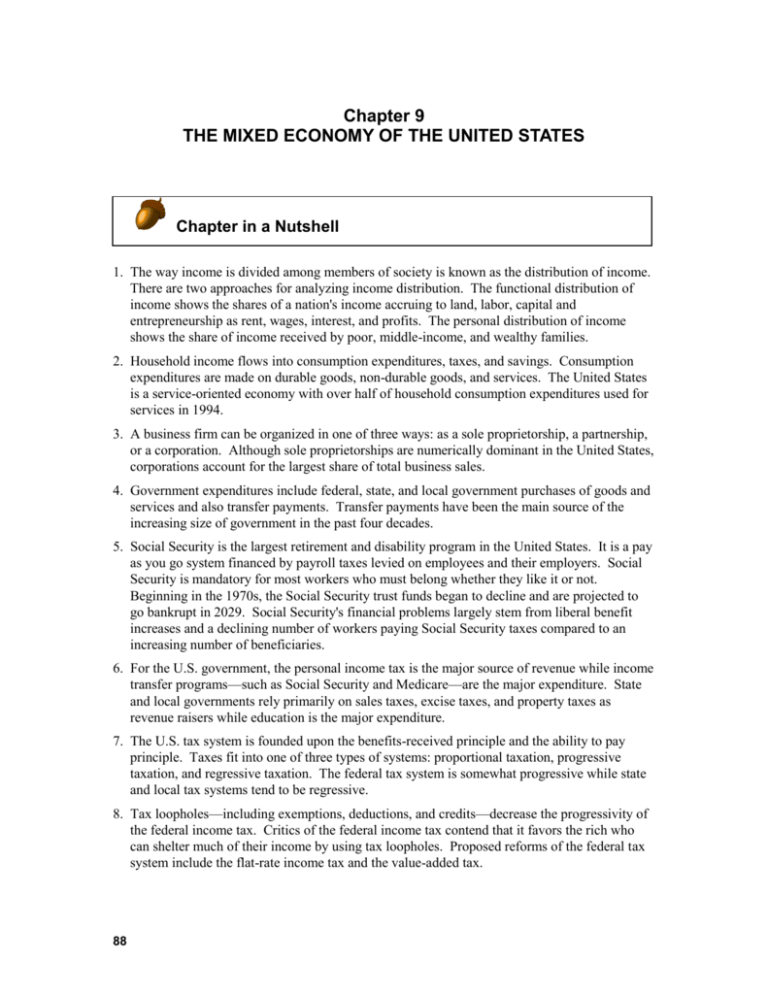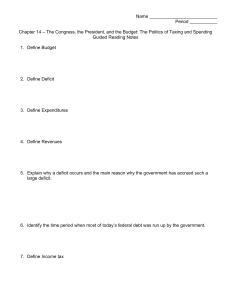Chapter 9 THE MIXED ECONOMY OF THE
advertisement

Chapter 9 THE MIXED ECONOMY OF THE UNITED STATES Chapter in a Nutshell 1. The way income is divided among members of society is known as the distribution of income. There are two approaches for analyzing income distribution. The functional distribution of income shows the shares of a nation's income accruing to land, labor, capital and entrepreneurship as rent, wages, interest, and profits. The personal distribution of income shows the share of income received by poor, middle-income, and wealthy families. 2. Household income flows into consumption expenditures, taxes, and savings. Consumption expenditures are made on durable goods, non-durable goods, and services. The United States is a service-oriented economy with over half of household consumption expenditures used for services in 1994. 3. A business firm can be organized in one of three ways: as a sole proprietorship, a partnership, or a corporation. Although sole proprietorships are numerically dominant in the United States, corporations account for the largest share of total business sales. 4. Government expenditures include federal, state, and local government purchases of goods and services and also transfer payments. Transfer payments have been the main source of the increasing size of government in the past four decades. 5. Social Security is the largest retirement and disability program in the United States. It is a pay as you go system financed by payroll taxes levied on employees and their employers. Social Security is mandatory for most workers who must belong whether they like it or not. Beginning in the 1970s, the Social Security trust funds began to decline and are projected to go bankrupt in 2029. Social Security's financial problems largely stem from liberal benefit increases and a declining number of workers paying Social Security taxes compared to an increasing number of beneficiaries. 6. For the U.S. government, the personal income tax is the major source of revenue while income transfer programs—such as Social Security and Medicare—are the major expenditure. State and local governments rely primarily on sales taxes, excise taxes, and property taxes as revenue raisers while education is the major expenditure. 7. The U.S. tax system is founded upon the benefits-received principle and the ability to pay principle. Taxes fit into one of three types of systems: proportional taxation, progressive taxation, and regressive taxation. The federal tax system is somewhat progressive while state and local tax systems tend to be regressive. 8. Tax loopholes—including exemptions, deductions, and credits—decrease the progressivity of the federal income tax. Critics of the federal income tax contend that it favors the rich who can shelter much of their income by using tax loopholes. Proposed reforms of the federal tax system include the flat-rate income tax and the value-added tax. 88 Chapter 9: The Mixed Economy of the Unites States 89 Chapter Objectives After reading this chapter, you should be able to: 1. Distinguish between the functional distribution of income and personal distribution of income. 2. Explain why some people earn more income than others. 3. Assess the advantages and disadvantages of a sole proprietorship, a partnership, and a corporation. 4. Identify the major sources of revenue and expenditures of the federal government and also of state and local governments. 5. Evaluate various proposals for reforming the Social Security system. 6. Identify the principles upon which the U.S. tax system is founded. 7. Explain how tax loopholes undermine the progressivity of the federal income tax. 8. Identify the advantages and disadvantages of a flat-rate income tax. Knowledge Check Key Concept Quiz 1. mixed economy _____ a. consists of both the private and public sectors 2. functional distribution of income _____ b. specifies that taxes should be paid in proportion to the benefits received 3. personal distribution of income _____ c. something corporations are subject to 4. sole proprietorship _____ d. the fashion in which income is shared by individual households 5. limited liability _____ e. an advantage for the stockholders of a corporation 6. double taxation _____ f. shows the shares of a nation’s income accruing to the factors of production 7. transfer payments 8. cost-of-living adjustment 9. benefits-received principle 10. ability-to-pay principle 11. marginal tax rate 12. value–added tax _____ g. fraction of additional income paid in taxes _____ h. a firm owned and operated by one individual _____ i. is collected at the various stages of production _____ j. is founded on the notion that people with greater income and wealth should be taxed at a higher rate _____ k. provide a safety net of income security for the poor and needy _____ l. periodic adjustments made to keep pace with inflation 90 Chapter 9: The Mixed Economy of the Unites States Multiple Choice Questions 1. The U.S. economy is a. b. c. d. run by the government pure capitalist economy a command economy a mixed economy 2. The functional distribution of income shows the shares of a nation’s income accruing to a. b. c. d. land, labor, capital, entrepreneurship the richest 25 percent the poorest 25 percent all of the above 3. Some of the most important determinants of income differences are a. b. c. d. age and discrimination differences in production resources and inheritance investment in human capital all of the above 4. A business firm may be organized in all of the following ways except a. b. c. d. a sole proprietorship a partnership a corporation a merger 5. The greatest disadvantage of a sole proprietorship is a. b. c. d. unlimited liability low profits small size limited liability 6. Corporations have the following drawbacks except a. they are subject to double taxation b. they suffer from separation of control c. they may increase the cost of doing business and decrease the dividends of stockholders d. they charge monopoly prices 7. Government expenditures consist of a. b. c. d. government purchases and transfer payments government purchases only transfer payments only welfare payments only Chapter 9: The Mixed Economy of the Unites States 8. The major governmental transfer payments have included all of the following except a. b. c. d. unemployment compensation Medicaid agricultural assistance Social Security 9. All of the following are true of the Social Security Trust Funds except a. they are accounts located at the U.S. Treasury b. they represent a promise (IOU) from the government c. they are pledges to obtain resources in the future equal to the value of the trust-fund accounts d. they hold money to pay benefits 10. All of the following is being considered as options for “saving” Social Security except a. b. c. d. decrease the income cap adopt means testing raise the retirement age fully tax Social Security benefits 11. One of the ways in which the federal government finances its debt involves a. b. c. d. issuing stock sold in stock markets all over the world charging for licenses borrowing from foreign banks selling securities to households, financial institutions and businesses 12. A toll charged on a bridge in Key West, Florida to pay for the bridge follows a. b. c. d. the benefits-received principle the ability to pay principle the fair tax principle the redistribution of income principle 13. A tax system is called regressive when as income rises a. b. c. d. the average tax rate and marginal tax rate increase the average tax rate and marginal tax rate decrease the average and marginal tax rate remains constant the marginal tax rate increases and the average tax rate decreases 14. Under a proportional tax system a. b. c. d. as income increases the average tax rate remains constant income increases the marginal tax rate remains constant is a flat tax system all of the above 91 92 Chapter 9: The Mixed Economy of the Unites States 15. Most economists argue that when federal, state and local taxes are combined, the overall tax system in the U.S. is roughly a. b. c. d. proportional regressive progressive unfair 16. The largest expenditure item of the federal government is a. b. c. d. national defense income transfer programs education interest on the public debt 17. If the income tax liability of Mary Smith increases from $2,000 to $3,000 as her income increases from $20,000 to $25,000, her marginal tax rate is a. b. c. d. 10 percent 13 percent 20 percent 25 percent 18. A tax is progressive when it a. b. c. d. emphasizes the benefit-received principle instead of the ability-to-pay principle takes more dollars from the rich than the poor takes a larger fraction of income as income increases is forward looking and enhances the growth of the economy 19. Compared to corporations, proprietorships and partnerships have the advantage of a. b. c. d. flexibility and simplicity unlimited liability limited liability ease of raising funds for investment 20. Which of the following is subject to Adouble taxation@ by corporations? a. b. c. d. salaries and wages paid by the corporation rental income received by the corporation interest income received by the corporation dividends paid by the corporation 21. The personal distribution of income indicates the share of national income a. b. c. d. received by one-fifth of families being spent on durable goods, nondurable goods, and services interest income received by the corporation dividends paid by the corporation Chapter 9: The Mixed Economy of the Unites States 93 22. About what percent of U.S. household income is devoted to personal consumption expenditures? a. b. c. d. 80-85% 60-65% 45-50% 30-35% 23. The largest share of U.S. personal consumption expenditures consists of a. durable goods b. nondurable goods c. services d. automobiles 24. Concerning U.S. business firms, _____ are numerically the most dominant while _____account for the greatest share of business receipts a. b. c. d. partnerships, proprietorships proprietorships, corporations corporations, partnerships partnerships, corporations 25. The U.S. system of social security is characterized by all of the following except a. b. c. d. is a pay as you go system financed by payroll taxes provides cost-of-living adjustments for beneficiaries allows workers to place all of their payroll taxes into personal retirement accounts provides retirement benefits and health insurance for the public 26. The U.S. social security tax a. b. c. d. is entirely a progressive tax is entirely a regressive tax is entirely a proportional tax has both proportional and regressive features 27. In its purest form a ____ would junk the existing array of different tax rates on personal income and replace them with a single tax a. b. c. d. progressive tax flat-rate tax regressive tax national sales tax True-False Questions 1. T F The United States is a manufacturing-oriented economy with over half of the household consumption expenditures used for goods. 2. T F Government expenditures include federal and state but not local government purchases of goods and services. 3. T F Transfer payments are not included in government expenditures. 94 Chapter 9: The Mixed Economy of the Unites States 4. T F Increase in defense expenditures has been the dominant source of the increasing size of government during the past four decades. 5. T F Social Security is projected to go bankrupt in 2031. 6. T F Sole proprietorships are the numerically dominant form of business in the United States. 7. T F Social Security is a pay-as-you-go system financed by payroll taxes levied only on employers. 8. T F Social Security is not a mandatory system. 9. T F The only approach for analyzing income distribution involves the analysis of the personal distribution of income. 10. T F Corporations account for the largest share of total business sales. 11. T F Household income flows into consumption and taxes. 12. T F The tax loopholes make the federal income tax more progressive. 13. T F VAT is just like a national sales tax. 14. T F VAT is a tax on consumption. 15. T F A flat-rate income tax is progressive. 16. T F Excise taxes are proportional. 17. T F Medicare is the major state expenditure. 18. T F Education and Social Security are the major expenditures of the federal government. 19. T F The gasoline tax is consistent with the benefits-received principle. 20. T F The Social Security Trust Fund is the ultimate risk pool. 21. T F Proposed reforms of the federal personal income tax include a flat-rate income tax, a valued-added tax, and a national sales tax. 22. T F The federal income tax system is highly regressive and the state and local tax system is somewhat progressive. 23. T F For state and local governments, the largest source of revenue is the personal income tax. 24. T F National defense spending comprises the largest share of expenditures for the U.S. government. 25. T F Sales taxes of state governments tend to be progressive. 26. T F Social security is the largest retirement and disability program in the United States. F Durable goods constitute the largest source of personal consumption expenditures for Americans. 27. T Chapter 9: The Mixed Economy of the Unites States Application Questions 1. In Flatland an income tax rate of 20 percent prevails. Use the table below to answer the questions that follow. Year Income (billions of dollars) 1999 25.000 2000 26.250 Tax (billions of dollars) a. What are the total tax payments in 1999? b. What are the total tax payments in 2000? c. What is the marginal tax rate? 2. Use the table below to answer the questions that follow. Year Income (billions of dollars) Tax (billions of dollars) 1998 20.000 4.000 1999 25.000 5.000 2000 26.250 5.625 a. What is the average tax rate in 1999? b. What is the average tax rate in 2000? c. What would you call this tax system? 95 96 Chapter 9: The Mixed Economy of the Unites States d. Does the marginal tax rate change between 1998 and 2000? How? e. What is the essential difference between the two tax systems described in questions 1 and 2? f. How would you characterize the difference between a regressive tax system and the one described in this question? g. Is our Social Security tax system similar to the one described in this question? h. Is the federal income tax similar to the one described in this question? Answers to Knowledge Check Questions Key Concept Answers 1. a 4. h 2. f 5. e 3. d 6. c 7. k 8. l 9. b 10. 11. 12. Multiple Choice Answers 1. d 6. d 2. a 7. a 3. d 8. d 4. d 9. d 5. a 10. a 11. 12. 13. 14. 15. d a b d a 16. 17. 18. 19. 20. b c c a d 21. 22. 23. 24. 25. a a c b c 26. d 27. b True-False Answers 1. F 6. T 2. F 7. F 3. F 8. F 4. F 9. F 5. F 10. T 11. 12. 13. 14. 15. F F T T F 16. 17. 18. 19. 20. F F F T T 21. 22. 23. 24. 25. T F F F F 26. T 27. F j g i Chapter 9: The Mixed Economy of the Unites States 97 Application Question Answers 1. a. $5 billion b. $5.25 billion c. The marginal tax rate is 20 percent. 2. a. The average tax rate is 20 percent. b. The average tax rate is 21 percent. c. A progressive tax system. d. Yes. Between 1998 and 1999 the marginal tax rate is 20 percent. However, between 1999 and 2000, the marginal tax rate is a whopping 50 percent! e. In Flatland, the average and marginal tax rates remain constant. In Liberland, the marginal tax rates increase, thus increasing the average tax rates. f. In a regressive tax system, the marginal tax rates decline as income increases. Hence, as income increases, the average tax rates decline. g. No. The Social Security tax system in the United States is regressive. h. Yes. The federal income tax system is progressive.






